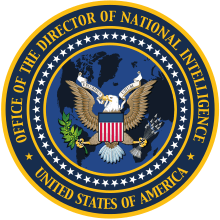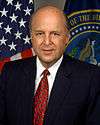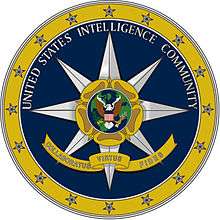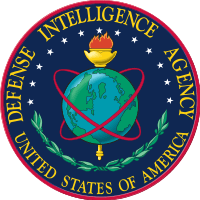Director of National Intelligence
The director of national intelligence (DNI) is the United States Government Cabinet-level official required by the Intelligence Reform and Terrorism Prevention Act of 2004 to:
- serve as head of the seventeen-member United States Intelligence Community
- direct and oversee the National Intelligence Program
- serve as an advisor, upon invitation, to the President of the United States and his executive offices of the National Security Council and the Homeland Security Council about intelligence matters related to national security
| Director of National Intelligence | |
|---|---|
 Seal of the Director of National Intelligence | |
| United States Intelligence Community | |
| Member of | Cabinet National Security Council (NSC) |
| Reports to | President of the United States |
| Seat | Washington, D.C. |
| Appointer | The president with Senate advice and consent |
| Constituting instrument | 50 U.S.C. § 3023 |
| Precursor | Director of Central Intelligence (DCI) |
| Formation | April 22, 2005 |
| First holder | John Negroponte |
| Deputy | Principal Deputy Director |
| Website | www |
The officeholder produces the President's Daily Brief (PDB), a top-secret document including intelligence from all the various agencies, given each morning to the president of the United States.[1] The PDB is seen by the president and other authorized individuals.
On July 30, 2008, President George W. Bush issued Executive Order 13470,[2] amending Executive Order 12333 to strengthen the DNI's role.[3] Further, by Presidential Policy Directive 19 signed by Barack Obama in October 2012, the DNI was given overall responsibility for Intelligence Community whistleblowing and source protection.
Under 50 U.S.C. § 403-3a, "under ordinary circumstances, it is desirable" that either the director or the principal deputy director of National Intelligence be an active-duty commissioned officer in the armed forces or have training or experience in military intelligence activities and requirements. Only one of the two positions can be held by a military officer at any given time. The statute does not specify what rank the commissioned officer will hold during his or her tenure in either position.
The DNI, who is appointed by the president and is subject to confirmation by the Senate, serves at the pleasure of the president. The current DNI is John Ratcliffe, who took office on May 26, 2020.
History
Founding
Before the DNI was formally established, the head of the Intelligence Community was the director of central intelligence (DCI), who concurrently served as the director of the Central Intelligence Agency (CIA).
The 9/11 Commission recommended establishing the DNI position in its 9/11 Commission Report, not released until July 22, 2004, as it had identified major intelligence failures that called into question how well the intelligence community was able to protect U.S. interests against foreign terrorist attacks.
Senators Dianne Feinstein, Jay Rockefeller and Bob Graham introduced S. 2645 on June 19, 2002, to create the director of national intelligence position. Other similar legislation soon followed. After considerable debate on the scope of the DNI's powers and authorities, the United States Congress passed the Intelligence Reform and Terrorism Prevention Act of 2004 by votes of 336–75 in the House of Representatives, and 89–2 in the Senate. President George W. Bush signed the bill into law on December 17, 2004. Among other things, the law established the DNI position as the designated leader of the United States intelligence community and prohibited the DNI from serving as the CIA director or the head of any other intelligence community element at the same time. In addition, the law required the CIA Director to "report" his agency's activities to the DNI.
Critics say compromises during the bill's crafting led to the establishment of a DNI whose powers are too weak to adequately lead, manage and improve the performance of the U.S. intelligence community.[4] In particular, the law left the United States Department of Defense in charge of the National Security Agency (NSA), the National Reconnaissance Office (NRO), and the National Geospatial-Intelligence Agency (NGA).[5]
Appointments
The first Director of National Intelligence was U.S. Ambassador to Iraq John Negroponte who was appointed on February 17, 2005, by President George W. Bush, subject to confirmation by the Senate. It was reported that President Bush's first choice for DNI was former Director of Central Intelligence Robert M. Gates, who was serving as president of Texas A&M University, but who declined the offer.[6] Negroponte was confirmed by a Senate vote of 98 to 2 in favor of his appointment on April 21, 2005, and he was sworn in by President Bush on that day.
On February 13, 2007, John Michael McConnell became the second Director of National Intelligence, after Negroponte was appointed Deputy Secretary of State.
Donald M. Kerr was confirmed by the U.S. Senate to be Principal Deputy Director of National Intelligence on October 4, 2007 and sworn in on October 9, 2007. Kerr, from Virginia, was most recently the Director of the National Reconnaissance Office and previously the duty director for science and technology at the CIA. Earlier in his career, he was Assistant Director of the Justice Department's FBI.
Declan McCullagh at News.com wrote on August 24, 2007, that the DNI site was configured to repel all search engines to index any page at DNI.gov. This effectively made the DNI website invisible to all search engines and in turn, any search queries.[7] Ross Feinstein, Spokesman for the DNI, said that the cloaking was removed as of September 3, 2007. "We're not even sure how (the robots.txt file]) got there" – but it was again somehow hidden the next day. Another blog entry by McCullagh on September 7, states that the DNI site should now be open to search engines.[8] This explanation is plausible because some software used for web development has been known to cause servers to automatically generate and re-generate robots.txt, and this behavior can be difficult to turn off. Therefore, if the web developers working for the DNI had tried to solve the issue by simply removing robots.txt, it would have looked like it worked at first, but then fail once the server had undergone a self-check for the robots.txt file.[9] robots.txt has been configured to allow access to all directories for any agent.
In September 2007, the Office of the DNI released "Intelligence Community 100 Day & 500 Day Plans for Integration & Collaboration". These plans include a series of initiatives designed to build the foundation for increased cooperation and reform of the U.S. Intelligence Community.[10]
On July 20, 2010, President Barack Obama nominated retired Lt. (three-star) Gen. James R. Clapper for the position. Clapper was confirmed by the Senate on August 5, and replaced acting Director David C. Gompert. The prior DNI was retired Navy four-star admiral Dennis C. Blair, whose resignation became effective May 28, 2010.[11]
Office of the Director of National Intelligence
The Intelligence Reform and Terrorism Prevention Act of 2004 established the Office of the Director of National Intelligence (ODNI) as an independent agency to assist the DNI. The ODNI's goal is to effectively integrate foreign, military and domestic intelligence in defense of the homeland and of United States interests abroad.[12] The budget for the ODNI and the Intelligence Community for fiscal year 2013 was $52.6 billion[13] and the base request for fiscal year 2014 was $48.2 billion.[14] The Military Intelligence Program (MIP) base budget request for fiscal year 2014, excluding overseas contingency funds, is $14.6 billion, which together with the NIP, comprises an Intelligence Community budget request of $62.8 billion for fiscal year 2014.[15] The ODNI has about 1,750 employees.[16]
On March 23, 2007, DNI John Michael McConnell announced organizational changes, which include:
- Elevating acquisition to a new Deputy DNI position
- Creating a new Deputy DNI for Policy, Plans, and Requirements (replacing the Deputy DNI for Requirements position)
- Establishing an Executive Committee
- Designating the Chief of Staff position as the new Director of the Intelligence Staff
The ODNI continued to evolve under succeeding directors, culminating in a new organization focused on intelligence integration across the community. The ODNI has six centers and 15 Offices that, together with the centers, support the Director of National Intelligence as the head of the Intelligence Community (IC) in overseeing and directing implementation of the NIP and acting as the principal advisor to the President, the National Security Council, and the Homeland Security Council for intelligence matters related to national security.
Organization
The ODNI leadership includes the director, principal deputy director and chief operating officer.[17] In addition, the Director of Defense Intelligence reports to the DNI.
There are four directorates, each led by a deputy director of national intelligence:[17][18]
- Enterprise Capacity Directorate
- Mission Integration Directorate
- National Security Partnerships Directorate
- Strategy & Engagement Directorate
There are four mission centers, each led by a director of that center:[17][18]
- Cyber Threat Intelligence Integration Center
- National Counterproliferation Center
- National Counterterrorism Center
- National Counterintelligence and Security Center
There are also four oversight offices:[17][18]
- Office of Civil Liberties, Privacy and Transparency
- Office of Equal Employment Opportunity & Diversity
- Office of the Intelligence Community Inspector General
- Office of General Counsel
Directors
Directors in chronological order
| No. | Director | Term of office | President(s) served under | |
|---|---|---|---|---|
| Position succeeded the Director of Central Intelligence | ||||
| 1 |  |
John Negroponte | April 21, 2005 – February 13, 2007 | George W. Bush |
| 2 | .jpg) |
Mike McConnell | February 13, 2007 – January 27, 2009 | |
| 3 | .jpg) |
Dennis C. Blair | January 29, 2009 – May 28, 2010 | Barack Obama |
| – | .jpg) |
David Gompert Acting |
May 28, 2010 – August 5, 2010 | |
| 4 | .jpg) |
James R. Clapper | August 5, 2010 – January 20, 2017 | |
| – | .jpg) |
Mike Dempsey Acting |
January 20, 2017 – March 16, 2017 | Donald Trump |
| 5 | .jpg) |
Dan Coats | March 16, 2017 – August 15, 2019 | |
| – | .jpg) |
Joseph Maguire Acting |
August 16, 2019 – February 20, 2020 | |
| – | .jpg) |
Richard Grenell Acting |
February 20, 2020 – May 26, 2020 | |
| 6 | .jpg) |
John Ratcliffe | May 26, 2020 – Present | |
Directors organized by length of service in office
| No. in office | Director | Days | Rank by length of term | President |
|---|---|---|---|---|
| James R. Clapper | ||||
| Dan Coats | ||||
| John Michael McConnell | ||||
| John Negroponte | ||||
| Dennis C. Blair | ||||
| John Ratcliffe |

Line of succession
The line of succession for the Director of National Intelligence is as follows:[19]
- Principal Deputy Director of National Intelligence
- Deputy Director of National Intelligence for Intelligence Integration
- Director of the National Counterterrorism Center
- Director of the National Counterintelligence and Security Center
- Inspector General of the Intelligence Community
Subordinates
Principal deputy directors of national intelligence
| Name | Term of office | President(s) served under |
|---|---|---|
| Michael Hayden | April 21, 2005 – May 26, 2006 | George W. Bush |
| Ronald L. Burgess Jr. Acting |
June 2006 – October 2007 | George W. Bush |
| Donald Kerr | October 2007 – January 2009 | George W. Bush |
| Ronald L. Burgess Jr. Acting |
January 2009 – February 2009 | Barack Obama |
| David C. Gompert | November 10, 2009 – August 2010 | Barack Obama |
| Stephanie O'Sullivan | February 18, 2011 – January 20, 2017 | Barack Obama |
| Susan M. Gordon | August 7, 2017 – August 15, 2019 | Donald Trump |
| Andrew P. Hallmana Acting |
October 30, 2019 – February 21, 2020 | Donald Trump |
| Neil Wileya Acting |
May 13, 2020 – Present | Donald Trump |
Chief Operating Officer
| Name | Term of office | President(s) served under |
|---|---|---|
| Deirdre Walsh | February 2018 – Present | Donald Trump |
Director of the Intelligence Staff/Chief Management Officer
| Name | Term of office | President(s) served under |
|---|---|---|
| Ronald L. Burgess Jr. | May 2007 – February 2009 | George W. Bush, Barack Obama |
| John Kimmons | February 2009 – October 2010 | Barack Obama |
| Mark Ewing | November 2010 – n/a | Barack Obama, Donald Trump |
Intelligence Community Inspector General
| Name | Term of office | President(s) served under |
|---|---|---|
| Charles McCullough | October 7, 2010 – March 2017[21] | Barack Obama, Donald Trump |
| Michael Atkinson | May 17, 2018 – Present | Donald Trump |
Deputy directors of national intelligence
| Name | Office | Term of office | President(s) served under |
|---|---|---|---|
| Beth Sanner | Mission Integration | May 2019[22] – Present | Donald Trump |
| Kevin Meiners[23] | Enterprise Capacity | n/a – Present | Donald Trump |
| Karen Gibson | National Security Partnerships | April 2019[24] – Present | Donald Trump |
| Corin Stone[25] | Strategy & Engagement | n/a – Present | Donald Trump |
Assistant directors of national intelligence
| Name | Office | Term of office | President(s) served under |
|---|---|---|---|
| Deborah Kircher | ADNI for Human Capital | October 2011[26] – Present | Barack Obama, Donald Trump |
| John Sherman | Intelligence Community Chief Information Officer | September 2017[27] – Present | Donald Trump |
| Trey Treadwell[28] | Chief Financial Officer | n/a – Present | Donald Trump |
| Catherine Johnston | ADNI for Systems and Resource Analyses | May 2018[29] – Present | Donald Trump |
| Roy Pettis[30] | ADNI for Acquisition, Procurement and Facilities | n/a – Present | Donald Trump |
| James Smith[31] | ADNI for Policy and Strategy (Acting) | n/a – Present | Donald Trump |
See also
- Title 32 of the CFR
- Intelligence Advanced Research Projects Activity
- Information Sharing Environment
- Intellipedia
- Joint Worldwide Intelligence Communications System (JWICS)
- National Intelligence Coordination Center
- The National Security Act of 1947
- Open source intelligence
- United States Joint Intelligence Community Council
- US intelligence community A-Space
References
- "CIA to Cede President's Brief to Negroponte", February 19, 2005, The Washington Post
- "Executive Order 13470". Federal Register. National Archives and Records Administration. July 30, 2008. Retrieved November 22, 2016.
- "Bush Orders Intelligence Overhaul". The New York Times. Associated Press. July 31, 2008.
- Kaplan, Fred (7 December 2004). "You Call That a Reform Bill?". Slate.
- The limited DNI role in leading the U.S. intelligence community is discussed on the intelligence community page.
- "Robert M. Gates profile". The Washington Post. November 8, 2006. Retrieved November 22, 2016.
- McCullagh, Declan (2007-08-24). "Feds use robots.txt files to stay invisible online. Lame". CNET. Retrieved 2014-02-14.
- McCullagh, Declan (2007-09-07). "National Intelligence Web site no longer invisible to search engines". CNET. Retrieved 2014-02-14.
- "Auto generated robots.txt file in WordPress". Codegrad. February 10, 2013. Archived from the original on August 9, 2013. Retrieved 2013-08-12.
- "Director of National Intelligence Moves Forward with Intelligence Reform" (PDF). ODNI News Release No. 20-07. DNI.gov. September 13, 2007.
- Miller, Greg (May 21, 2010). "Dennis C. Blair to resign as Director of National Intelligence". The Washington Post. Retrieved June 3, 2010.
- "Public Affairs Office, ODNI". Office of the Director of National Intelligence. ODNI. Archived from the original on 19 March 2013. Retrieved 14 April 2013.
- "National Intelligence Program" (PDF). Budget for Fiscal Year 2013. US Government Publishing Office. p. 85. Retrieved 14 Apr 2013.
- "National Intelligence Program" (PDF). The Budget for Fiscal Year 2014. US Government Publishing Office. p. 75. Archived from the original (PDF) on 19 April 2013. Retrieved 14 April 2013.
- "DoD Releases MIP Base Request for FY 2014". Department of Defense. Archived from the original on 12 April 2013. Retrieved 14 April 2013.
- Clark, Charles (September 2012). "Lifting the Lid". Government Executive. Archived from the original on 2 January 2014. Retrieved 14 April 2013.
- "Leadership". Office of the Director of National Intelligence. Retrieved 2019-09-27.
- "Organization". Office of the Director of National Intelligence. Retrieved 2019-09-27.
- "Designation of Officers of the Office of the Director of National Intelligence To Act as Director of National Intelligence". Federal Register. 78 FR 59159. 2013-09-25. Retrieved 2016-10-30.
- "Andrew Hallman Joins the Office of the Director of National Intelligence as Principal Executive". dni.gov. October 31, 2019. Retrieved 28 May 2020.
- Poulsen, Kevin (February 12, 2018). "U.S. Intelligence Shuts Down Damning Report on Whistleblower Retaliation" – via www.thedailybeast.com.
- "Deputy DNI for Mission Integration". www.dni.gov. Retrieved 2019-08-09.
- "Deputy DNI, Enterprise Capacity". www.dni.gov. Retrieved 2019-08-09.
- "Karen Gibson Named Deputy Director of National Intelligence". Executive Gov. 2019-04-23. Retrieved 2019-08-09.
- "Deputy DNI, Strategy & Engagement". www.dni.gov. Retrieved 2019-08-09.
- "Assistant DNI, Chief Human Capital Office". www.dni.gov. Retrieved 2019-08-09.
- "Chief Information Officer". www.dni.gov. Retrieved 2019-08-09.
- "Leadership". www.dni.gov. Retrieved 2019-08-09.
- "Assistant DNI, Systems & Resource Analyses". www.dni.gov. Retrieved 2019-08-09.
- "NRO Honored at Intelligence Community Acquisition, Facilities, and Log". National Reconnaissance Office. Retrieved 2019-08-09.
- "Assistant DNI, Policy & Strategy". www.dni.gov. Retrieved 2019-08-09.

